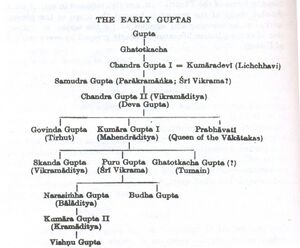Budhagupta

Budhagupta (476-495 AD) was ruler of Gupta Empire. Narasimhagupta (467-473) was followed by Kumaragupta II (473-476) and Budhagupta (476-495?).
In the 480's the Hephthalite king Toramana broke through the Gupta defenses in the northwest, and much of the empire was overrun by the Hunas by 500. The empire disintegrated under the attacks of Toramana and his successor, Mihirakula; the Hunas conquered several provinces of the empire, including Malwa, Gujarat, and Thanesar, broke away under the rule of local dynasties. It appears from inscriptions that the Guptas, although their power was much diminished, continued to resist the Hunas, and allied with the independent kingdoms to drive the Hunas from most of northern India by the 530's. The succession of the sixth-century Guptas is not entirely clear, but the last recognized ruler of the dynasty's main line was Vishnugupta, reigning from 540 to 550.
Inscriptions of Budhagupta
Personal and geographical names in the Gupta inscriptions by Tej Ram Sharma provides list of following inscriptions of Budhagupta:
- 18. Eran Stone Pillar Inscription of Budhagupta Gupta Year 165 (=A.D. Hz. p. 334, 484) (Dx)1 , p.89
- 53. Nalanda Seal of Budhagupta....JJ. XIX, p. 119; Hz. p.339
- 54. Sarnath Buddhist Stone Image Inscription of Budhagupta Gupta Year 157 (=A. D. 476)....CJ. 1914-15, pp. 124-25;Hz. p. 332
- 55. Varanasi Pillar Inscription of the time of Budhagupta Gupta Year 1 59 (= A.D. 478)....LJ. XV,1949, p. 5;Hz. p. 332
Varanasi Pillar Inscription of the time of Budhagupta Gupta Year 159 (= A.D. 478)
See - Journal and Proceedings of the Asiatic Society of Bengal, Calcutta. XV,1949, p. 5;Select Inscriptions by D. C. Sircar. p. 332
Damodarpur Copper-plate Inscription of the time of Budhagupta (=A.D. 476-94)
Ref - Epigraphia Indica XV, p.138, Select Inscriptions by D. C. Sircar p. 336
Damodarpur Copper-plate Inscription of the time of Budhagupta Gupta Year 163 (=A.D.482)
Ref - Epigraphia Indica XV, p.135, Select Inscriptions by D. C. Sircar p. 332
Eran Stone Pillar Inscription of Budhagupta (484-485 CE)
- Victorious is the lord, the four-armed (god Vishnu)— whose couch is the broad waters of the four oceans; who is the cause of the continuance, the production, and the destruction, &c., of the universe; (and) whose ensign is Garuda!
- (Line 2.)— In a century of years, increased by sixty-five; and while Budhagupta (is) king; on the twelfth lunar day of the bright fortnight of the month Âshâdha; on the day of Suraguru; (or in figures) the year 100 (and) 60 (and) 5:—
- (L. 3.)— And while Surashmichandra is governing, with the qualities of a regent of one of the quarters of the world, (the country that lies) between the (rivers) Kâlindi and Narmadâ, (and) is enjoying in the world the glory of (being) a Mahârâja;—
- (L. 4.)— On this (lunar day), (specified) as above by the year and month and day; — by the Mahârâja Mâtrivishnu, who is excessively devoted to the Divine One; who, by the will of (the god) Vidhâtri, was approached (in marriage-choice) by the goddess of sovereignty, as if by a maiden choosing (him) of her own accord (to be hey husband); whose fame extends up to the borders of the four oceans; who is possessed of unimpaired honour and wealth; (and) who has been victorious in battle against many enemies;—who is the son of the son's son of Indravishnu, who was attentive to his duties; who celebrated sacrifices; who practised private study (of the scriptures); who was a Brâhman saint; (and) who was the most excellent (of the followers) of the Maitrâyanîya (sâkhâ);— who is the son's son of Varunavishnu, who imitated the virtuous qualities of (his) father;— (and) who is the son of Harivishnu, who was the counterpart of (his) father in meritorious qualities, (and) was the cause of the advancement of his race;—
- (L. 8.)— (By him) and by his younger brother Dhanyavishnu, who is obedient to him, (and) has been accepted with favour by him,— this flag-staff of the divine (god) Janârdana, the troubler of the demons, has been erected, for the purpose of increasing the religious merit of (their) parents.
- (L. 9.)— Let prosperity attend all the subjects, headed by the cows and the Brâhmans!
- From: Fleet, John F. Corpus Inscriptionum Indicarum: Inscriptions of the Early Guptas. Vol. III. Calcutta: Government of India, Central Publications Branch, 1888, 90.
Further readings
- पाठ 5- धारण जाटों का साम्राज्य पुस्तक, जाट प्राचीन शासक; लेखक बी. एस. दहिया।
Back to The Rulers

